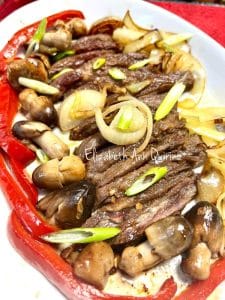Upo Guisado Omelet
As an Amazon Associate and member of other affiliate programs, I earn from qualifying purchases.
When we were children, my parents had no difficulty feeding my sister and I vegetables like a classic Filipino Upo Guisado Omelet—especially because my father grew upo (bottle gourd) in our backyard. But when I had children of my own, it was a challenge to make my sons eat vegetables, so I came up with ways they would enjoy them like this Tortilyang Upo, an omelet made of the sauteed bottle gourd.
Compared to my childhood in the Philippines, where flavors were simpler and more basic back then, my sons grew up in America where their palates were exposed to a myriad of tastes, aromas and textures from diverse cultures – because after all, that is America, a melting pot. Explaining why they needed to eat vegetables beyond French Fries was tough. Often, I had to sneak in the veggies in creative ways. Sometimes, I even had to offer a reward.
Now that my sons are grown, my persistence has paid off. They eat their vegetables with no questions asked. Even better, they’ve grown to be more health-conscious and embrace wellness as a way of life. Both my sons grew up as unique individuals with varying preferences for food, yet at the end of the day they both gravitate to cooking their own wholesome meals.
One thing my younger son was fascinated with when he was little was the bottle gourd or upo (say “ooh-poh”) as we call it in the Philippines. I often told him stories about how the gourd, growing from a vine, took on the shape of a bottle that was hung next to it.
I told my son that when I was a child, I thought the upo growing in our backyard looked like a stout baseball bat because of its length – about 12 to 14 inches. When the upo was harvested, the upo felt heavy in my arms. As a backyard vegetable, my mother had many recipes for upo. I remember well the upo guisado – sautéed in garlic, onions, tomatoes. Once I heard the sizzle of the garlic and onions and smelled the aroma of the patis (fish sauce) used for seasoning, I knew lunch or dinner would be ready soon.
I found upo in the Asian markets last week and I was delighted I could make my favorite guisado recipe. I took it a step further and whipped up some eggs till they were light and fluffy. Then I poured the beaten eggs around the skillet where the sautéed upo was simmering. The result was a heavenly omelet, as light as a cloud, yet moist and savory enough to enjoy with a bowl of boiled white rice.
I sliced the ‘tortilyang upo’ as my mom called it and the golden yellow omelet encasing the light green cubes of gourd glistened invitingly. I placed the omelet piece on a bed of rice on my plate and the comforting aroma of the cooked eggs with the sautéed vegetables was all I needed to make things seem okay in this moment in our world today.
Upo Guisado Omelet
Equipment
- Large Non-stick Skillet: 10 inches or 12 inches in diameter
Ingredients
- 2 Tablespoons vegetable oil
- 2 cloves garlic minced
- 1 whole onion chopped
- 1 Tablespoon patis (fish sauce) fish sauce
- 1 whole large tomato chopped, about 3/4 cup
- 1/2 cup organic vegetable broth
- 2 cups cubed upo (bottle gourd) cut about 1/2-inch sized pieces
- 1 cup sliced green beans cut into 1-inch in length pieces
- 4 whole large eggs beaten
- 1 teaspoon salt
- 1 teaspoon ground black pepper powder
- 1 to 2 stalks scallions chopped, for garnish
- for serving: boiled rice
Instructions
To prepare the upo (bottle gourd):
- Wash an entire upo with soap and water. Pat dry with paper towels. Peel off the outer skin.Slice the upo open horizontally, in half. Remove the seeds and white spongy parts inside.Slice the light green flesh into 1/2 inch-sized cubes. You should have two cups from a large gourd for this recipe. Set the cubed upo aside.
- To cook the upo: In a large, non-stick skillet (about 10 inches in diameter), over medium-high heat, add the oil.When oil is hot enough, saute the garlic and onions for 1 to 2 minutes. Add the patis (fish sauce) and tomatoes. Continue saute for 2 minutes till tomatoes are soft.Pour the vegetable broth. Add the upo cubes and green beans. Cover and cook for 8 to 10 minutes till vegetables are soft and the upo cubes are transparent.
- To cook the omelet: In a separate, medium-sized bowl, beat the eggs till fluffy. Season with salt and pepper.When the vegetables cooking in the skillet are soft and cooked, pour the beaten eggs all over the skillet.
- Tilt the skillet around so the eggs spread well and all the vegetables are covered evenly.Cover the skillet and turn the heat down to a low simmer. Cook for 5 minutes more.When the eggs solidify, turn off the heat. Keep the skillet covered on the stove top. The residual heat of the skillet will continue to cook the omelet. This gives the omelet a moist texture.
- Garnish the tortilyang upo with chopped scallions. Serve warm with boiled rice.
Cook's comments:
- At times, the upo or bottle gourd is large, so I only use half of it. If there is leftover uncooked upo, cover the entire gourd with plastic wrap, then with aluminum foil. Keep refrigerated. Use within 1 to 2 days.
Nutrition
Notes on Nutrition: The nutrition information provided is an estimate and will vary based on cooking methods and specific brands of ingredients used.
Did you like this recipe? I have more classic recipes inspired by my late mother’s cooking in my popular cookbook: My Mother’s Philippine Recipes. If you’re learning how to cook Filipino food or a fan of Philippine cuisine, buy my cookbooks and books on Amazon.com sold worldwide in paperback and Kindle format.
Hello, Friends! Please DO NOT LIFT OR PLAGIARIZE my original recipe, stories, photos or videos. All the images and content on this blog are COPYRIGHT PROTECTED and owned by my media company Besa-Quirino LLC. This means BY LAW you are NOT allowed to copy, scrape, lift, frame, plagiarize or use my photos, essays, stories and recipe content on your websites, books, films, television shows, videos, without my permission. If you wish to republish this recipe or content on media outlets mentioned above, please ASK MY PERMISSION, or re-write it in your own words and link back to my blog AsianInAmericaMag.com to give proper attribution. It is the legal thing to do. Thank you. Email me at [email protected]











Goid afternoon.
I wasloking for a recipe for upo for dinner and i saw your recipe.
I have not tried cooking upo this way before. Reading your article makes me feel it is worth the try.
Thanks
Thanks, Gracita. Enjoy!